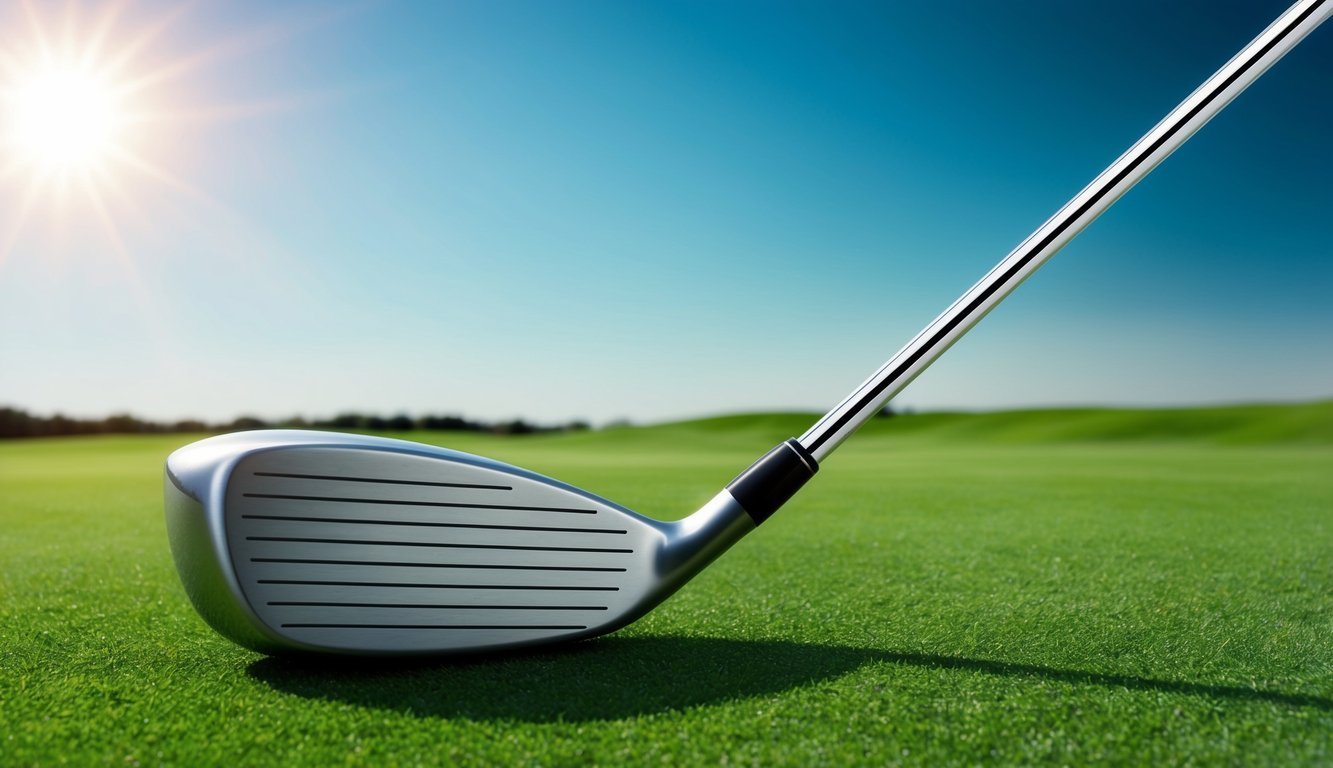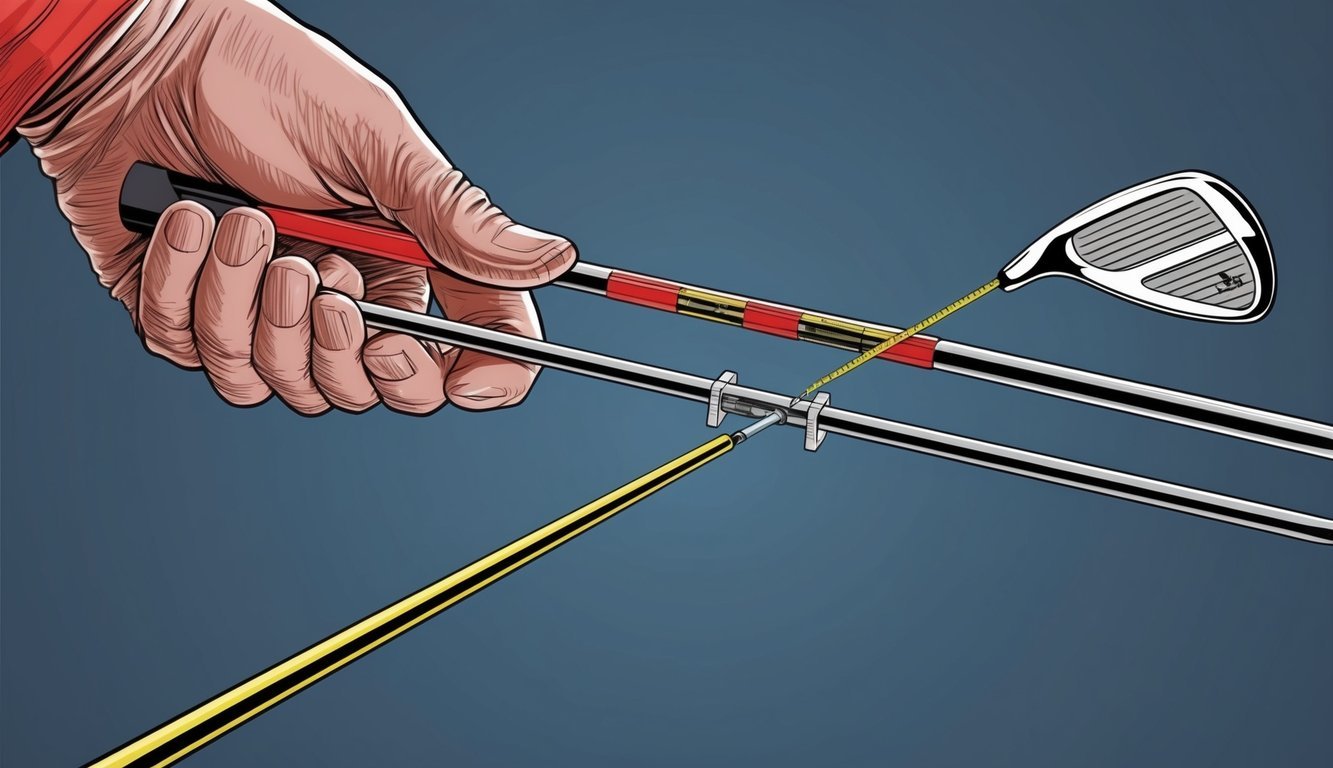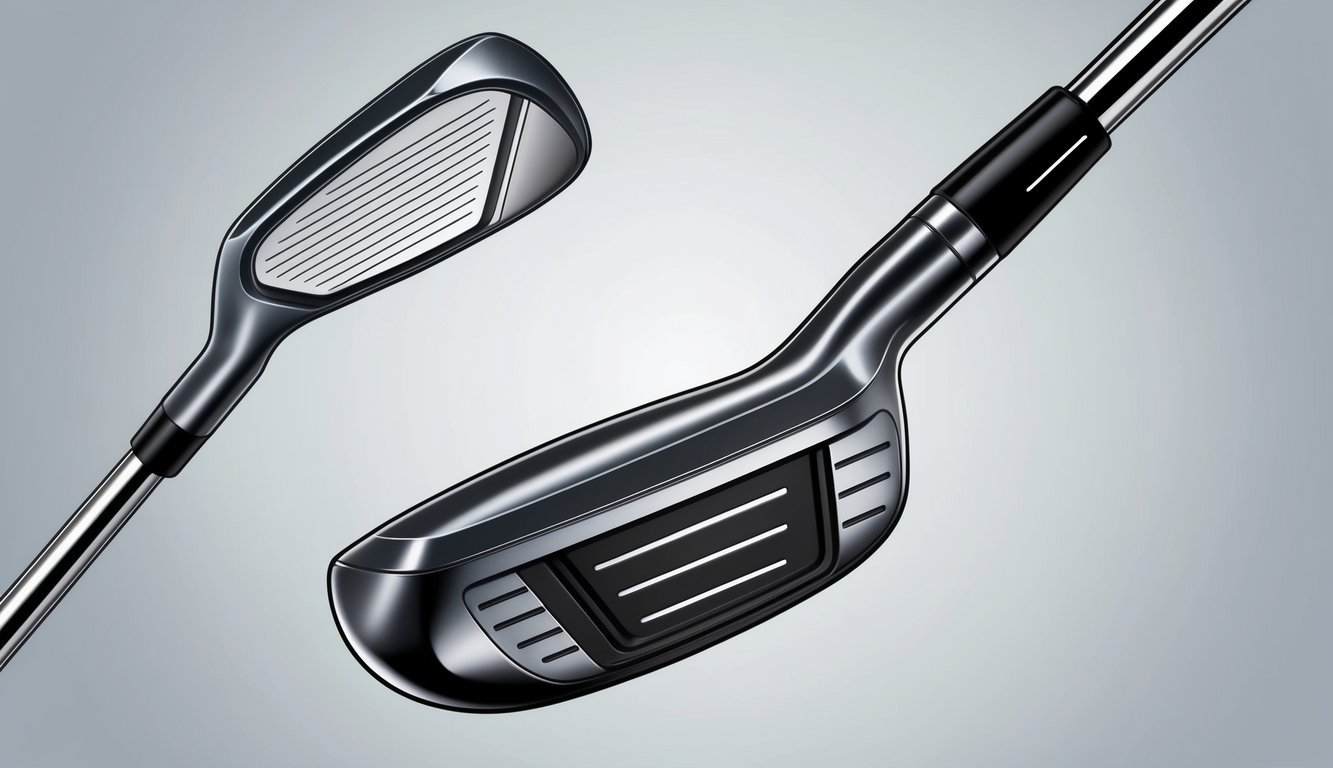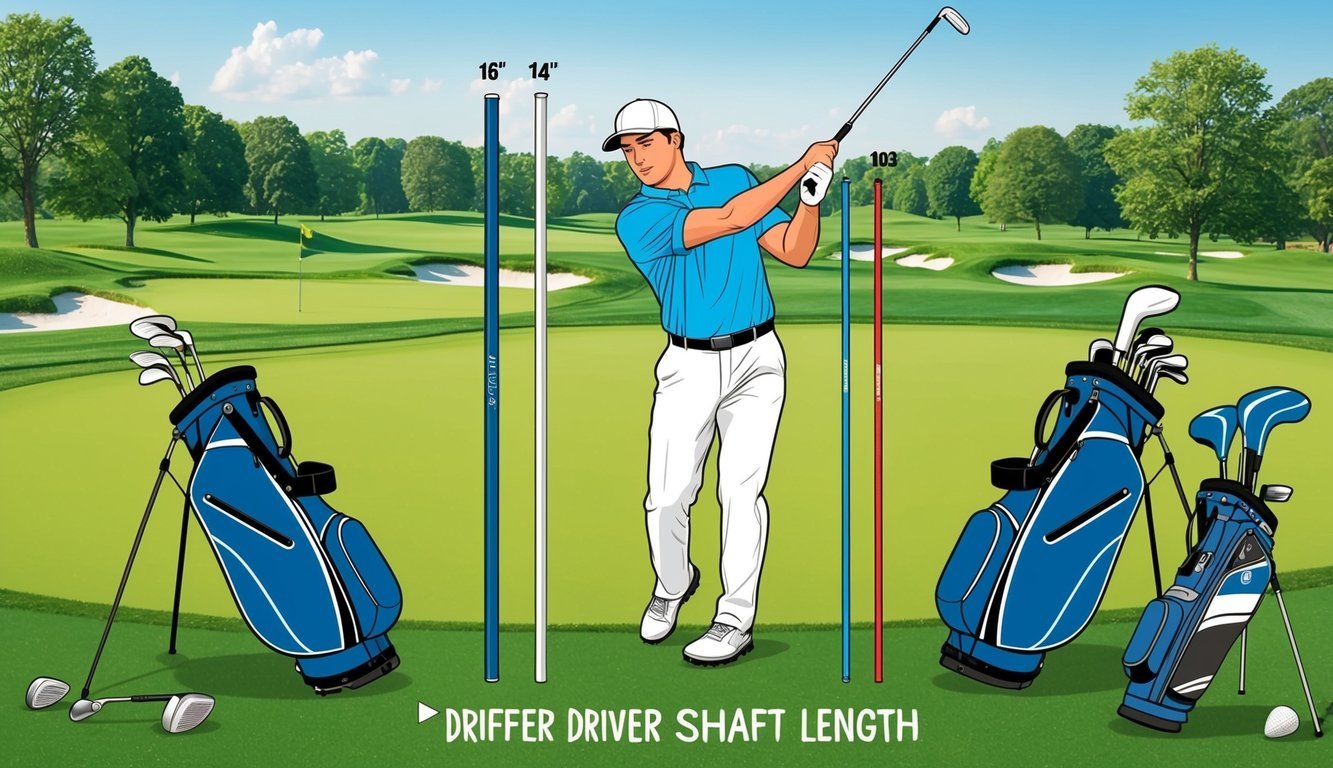Understanding the standard length of a driver shaft is crucial for any golfer aiming to enhance their performance on the course.
Knowing the ideal shaft length can directly impact your swing speed, accuracy, and distance.
For men, the typical driver shaft length is around 45 inches.
Meanwhile, for women, it commonly stands at 44 inches.
However, these measurements can vary based on individual preferences and physical attributes.

Selecting the right driver shaft length plays a vital role in optimizing your game.
Tailoring your driver to fit your specific needs can make a significant difference, often leading to improved form and lower scores.
With advancements in golf technology, you have the opportunity to fine-tune your equipment, ensuring that it matches your individual playing style and physical characteristics.
Custom fitting is an essential aspect of modern golf, allowing players to choose their ideal equipment.
By exploring different shaft lengths and configurations, you can discover what works best for your game and potentially elevate your skills.
Key Takeaways
- Standard driver shaft lengths are 45 inches for men and 44 inches for women.
- Choosing the right shaft length improves your swing speed and accuracy.
- Custom fitting allows for selecting optimal equipment for your game.
The Importance of Driver Shaft Length
Understanding driver shaft length is crucial for boosting your game.
The length can significantly influence how far and accurately you can hit the ball.
These factors rely on how shaft length impacts swing speed and ball speed, ultimately affecting performance.
Impact on Distance and Accuracy
The driver shaft length plays a major role in the distance and accuracy of your shots.
A longer shaft can potentially increase the distance you achieve from the tee.
This is because longer shafts may increase swing speed, leading to a higher ball speed and potentially longer shots.
However, a longer shaft may also challenge accuracy, as it can be harder to control.
Many golfers find it beneficial to adjust their driver length to match their abilities and style of play.
If you find that longer shafts compromise your control, opting for a standard driver shaft length may improve accuracy.
Finding the right balance between length and control can help you find the club’s sweet spot consistently, improving your game.
Effect on Swing Speed and Ball Speed
Driver shaft length can affect swing speed and ball speed, both critical factors in golf.
Generally, a longer shaft increases swing distance, which can translate into greater speed.
This added speed may produce faster ball speeds, resulting in longer shots.
However, it’s crucial to consider how these factors interact.
While longer shafts can increase speed, they might reduce swing weight control.
This means you might hit the ball less consistently, affecting accuracy.
Adjusting shaft length to your comfort and swing might provide a better combination of speed and control, helping you achieve lower scores.
Standard Measurements and Variations
When selecting a driver shaft, it’s crucial to understand the standard measurements and how factors like height and posture influence the optimal shaft length for you.
Average Driver Length for Men and Women
The standard driver shaft length for men typically ranges from 45 to 45.75 inches, while for women, it ranges from 43.75 to 44.75 inches.
These measurements offer a baseline, ensuring a balance between control and power.
For men, a driver shaft length of around 45 inches is common, enhancing swing speed and accuracy.
Meanwhile, women often benefit from a slightly shorter shaft, which can provide better control and ensure that the club isn’t excessively cumbersome during swings.
How Height and Posture Influence Shaft Length
Your height and posture significantly influence the ideal shaft length for you.
Taller individuals may require longer shafts to accommodate their reach and optimize swing mechanics.
For instance, if you stand between 6’1″ and 6’4″, a shaft length of about 45.5 inches might suit you best.
The wrist-to-floor measurement is another critical factor.
This simple measurement can help determine whether a standard length is right or if adjustments are needed.
A golfer with a unique posture may need modifications in shaft length to ensure better alignment and swing efficiency.
Custom Fitting for Optimal Performance

Custom fitting your golf clubs can significantly enhance your performance off the tee.
It involves professional club fitters analyzing various aspects of your game to determine the ideal driver shaft length and other specifications for your swing.
The Role of Professional Club Fitters
Professional club fitters play a vital role in optimizing your golf game.
They possess the expertise to evaluate your swing mechanics, physical attributes, and playing style.
By using advanced equipment, such as launch monitors, they gather precise data regarding your ball flight, swing speed, and accuracy.
Fitters then use this data to recommend adjustments that align with your personal requirements.
Their aim is to ensure each club enhances your performance, offering you the best chance at achieving consistency and greater distance off the tee.
Collaboration with a club fitter should resemble a partnership.
You should discuss your experiences, preferences, and goals.
This dialogue helps the fitter tailor the session to not only meet industry standards but also address your individual needs.
The outcome is a set of clubs that feel custom-built for you.
Identifying the Ideal Driver Shaft Length
Finding the ideal driver shaft length is a critical aspect of custom fitting.
It begins with an assessment of your height and wrist-to-floor measurement, which are essential in determining the appropriate shaft length.
A well-fitted shaft length can directly influence the launch angle and ball flight.
Longer shafts might increase distance, but they can compromise control.
Conversely, shorter shafts often provide better accuracy but might reduce distance.
Collaborating with a professional fitter ensures you find a balanced shaft length.
Manufacturers offer a variety of lengths, but only a fitting session can identify the one that perfectly suits your swing.
Achieving this balance can improve both your distance and accuracy, resulting in an all-around better performance on the course.
Advancements in Golf Technology

Golf technology has significantly advanced, allowing players to maximize their performance through innovative materials and precise club fitting.
These advancements impact the length and performance of golf clubs, particularly driver shafts.
Influence of Equipment and Material on Length
In recent years, golf equipment has seen considerable improvements, especially in the materials used for clubheads and shafts.
The incorporation of lightweight carbon composites and titanium in both the clubhead and shaft has enabled manufacturers to extend the length of driver shafts without compromising swing speed or control.
These materials offer increased strength and flexibility, which enhances the club’s performance.
A longer shaft, supported by advanced materials, can help increase swing speed, contributing to longer drives.
When selecting your equipment, be mindful of the legal regulations in place for driver shaft lengths, as they ensure fair competition and maintain the integrity of the sport.
How Technology Enhances Club Fitting
Club fitting has been transformed by technology, with tools and systems enabling personalized customization to optimize performance.
Modern fitting techniques employ launch monitors to measure key metrics like swing speed, launch angle, and ball flight trajectory, helping you find the ideal club specifications.
With these tools, you can adjust shaft length, stiffness, and clubhead angles to suit your swing style.
This precise custom fitting results in improved shot accuracy and distance, allowing you to reach your full potential on the course.
Choosing the Right Shaft for Your Game

Selecting the best driver shaft involves considering a variety of factors tailored to individual needs.
Understanding these aspects can enhance your performance, whether you’re playing casually or aiming for professional levels.
Factors for Amateurs and Professional Golfers
For amateur players, the emphasis is on enhancing control and confidence.
Shaft flexibility plays a crucial role, as a more flexible shaft can help with higher ball launch and added distance.
Meanwhile, professional players often prefer stiffer shafts to maximize control and precision due to their advanced skill levels.
Your physical build should also influence your choice.
Both male and female golfers should consider their height and swing speed.
Using a driver shaft length chart can assist in selecting the right specifications for optimal results.
Adjustments for Age, Strength, and Experience
Your choice of golf driver shaft is significantly impacted by age and strength.
Younger players with more muscle power may favor longer shafts, as this can increase swing speed.
On the other hand, older or less strong players might benefit from shorter, more flexible shafts for ease of control.
Experience level should also guide shaft selection.
Beginners may prioritize forgiving shafts that compensate for inconsistencies in their swing.
Meanwhile, more experienced players often seek customized shafts for specific play styles to maximize their game’s effectiveness.
Adjust your selection according to what enhances your comfort and performance the most.

